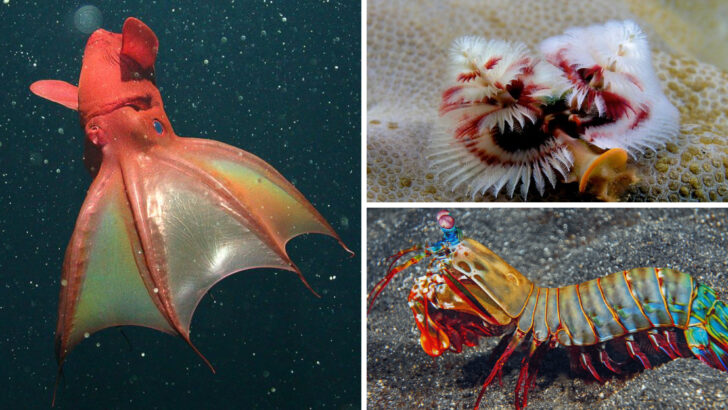The ocean is a vault of secrets, hiding creatures so bizarre they seem ripped from science fiction. Just when we think we’ve seen it all, the deep unveils something stranger, something wilder.
Some of these animals glow like living neon signs. Others shapeshift, turning invisible in an instant. And a few? They look like they were dreamed up by a sleep-deprived artist with a thing for tentacles and teeth.
From ghostly deep-sea predators to gelatinous blobs that defy classification, these 24 ocean dwellers prove that nature has a wild imagination. Get ready to meet some of the weirdest life forms lurking beneath the waves!
Blobfish
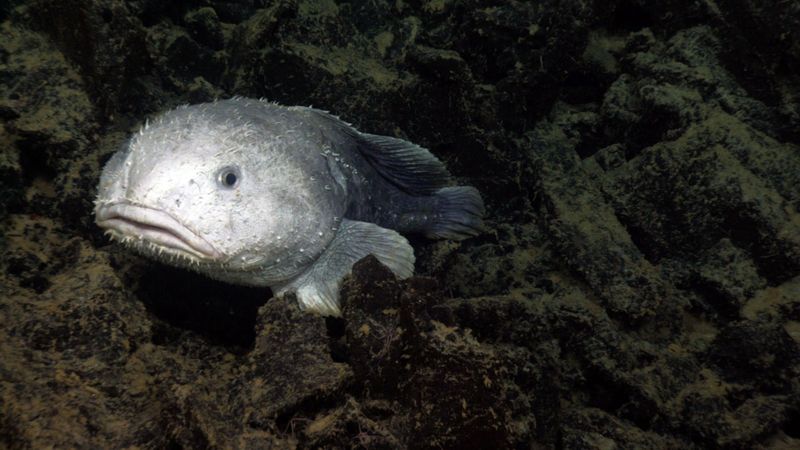
The blobfish, often called one of the ugliest animals, doesn’t worry much about looks. This deep-sea dweller is all about survival. Its gelatinous body allows it to float above the sea floor with minimal energy. In the depths of the ocean, its saggy skin becomes streamlined, making it more efficient. Despite its appearance, the blobfish is a master of adaptation. Found primarily off the coast of Australia and Tasmania, it survives in waters that would crush most other creatures. Its unique body structure is a testament to nature’s creativity and adaptability.
Dumbo Octopus
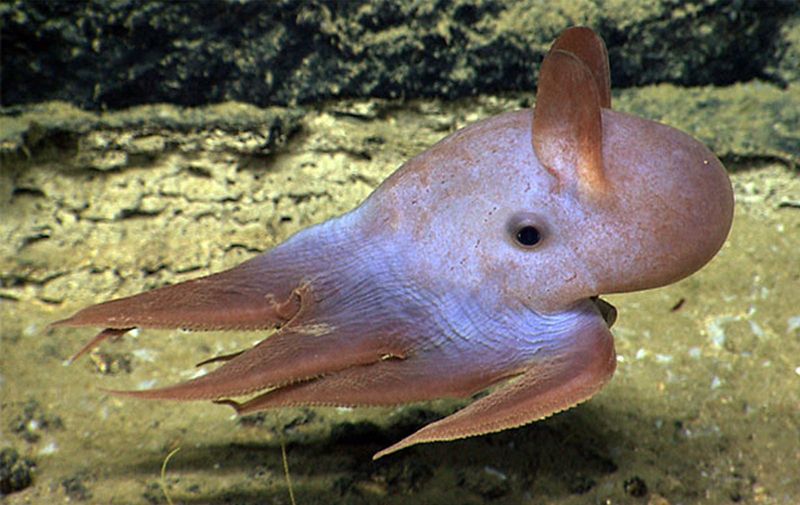
The Dumbo octopus, named for its ear-like fins resembling Disney’s beloved elephant, captivates marine enthusiasts. Unlike its namesake, this octopus glides gracefully through the ocean depths. Found at extreme depths, often over 13,000 feet, its translucent body appears almost otherworldly. These creatures use their unique fins to navigate through the water with elegance. They come in a variety of colors, from ghostly white to vibrant orange. Each sighting of the Dumbo octopus offers a glimpse into a world rarely seen by human eyes, highlighting the diversity of ocean life.
Leafy Seadragon
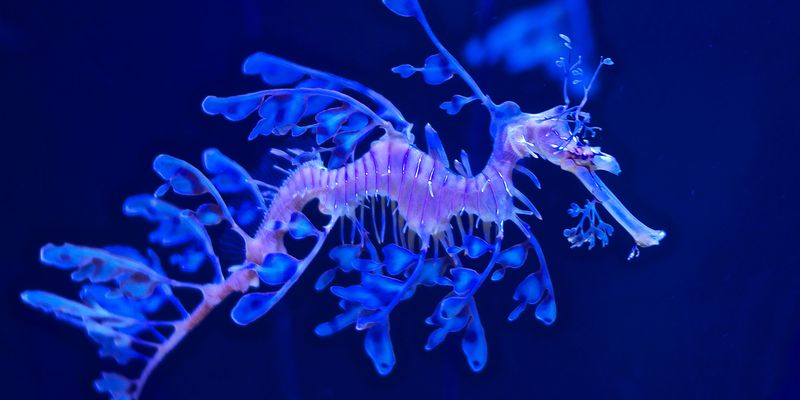
The leafy seadragon, a master of disguise, enchants those who are lucky enough to spot it. Resembling a piece of drifting seaweed, it blends seamlessly into its surroundings. This remarkable camouflage is its primary defense against predators. Found along the southern and western coasts of Australia, the leafy seadragon sways gently with ocean currents. Its delicate, leaf-like appendages are both beautiful and functional, aiding in movement. Watching a leafy seadragon is like observing a living work of art, a testament to the intricate beauty of marine evolution.
Goblin Shark
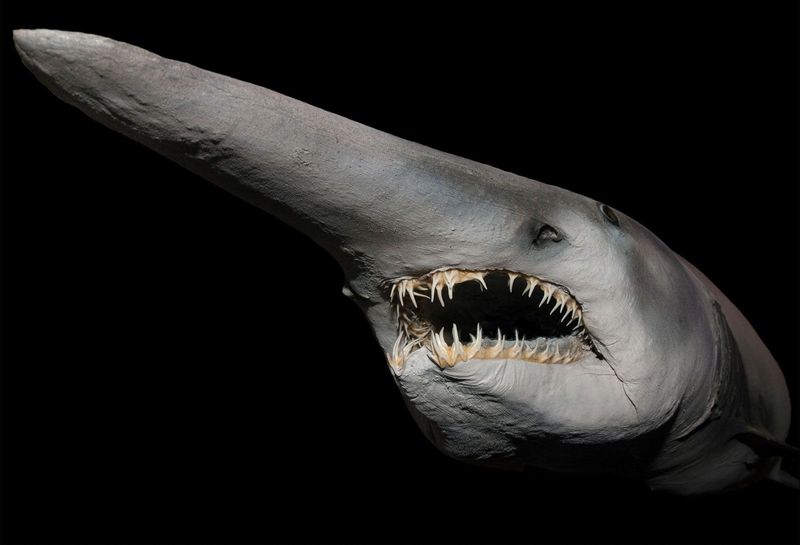
The goblin shark, often called a living fossil, is a creature that seems to have swum straight out of a prehistoric ocean. Its elongated snout and protruding jaws give it a fearsome appearance. Found in deep waters around the world, it’s rarely seen by humans. The goblin shark’s pinkish hue comes from visible blood vessels beneath its translucent skin. Its jaws can extend dramatically, allowing it to catch prey with precision. Though it may look terrifying, the goblin shark poses no real threat to humans, adding intrigue to its mysterious existence.
Axolotl
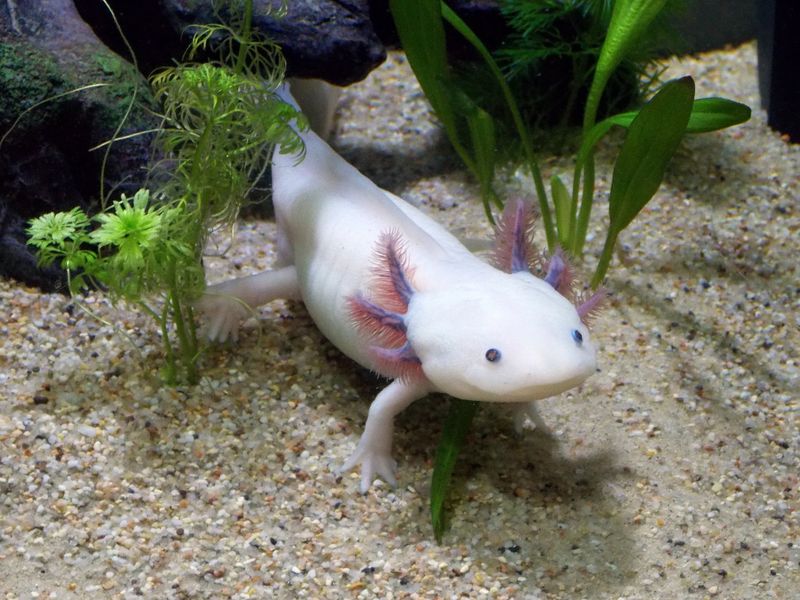
The axolotl, a creature often associated with myths, is a fascinating amphibian. Known for its unique ability to regenerate limbs, it captures the curiosity of scientists and enthusiasts alike. Unlike most amphibians, axolotls remain in their larval stage throughout life. This neoteny allows them to retain their gills and aquatic lifestyle. Found primarily in the freshwater lakes of Mexico, their population is declining due to habitat loss. Despite this, they thrive in captivity, where they are studied for their regenerative capabilities. The axolotl’s charming smile and abilities make it truly extraordinary.
Mantis Shrimp
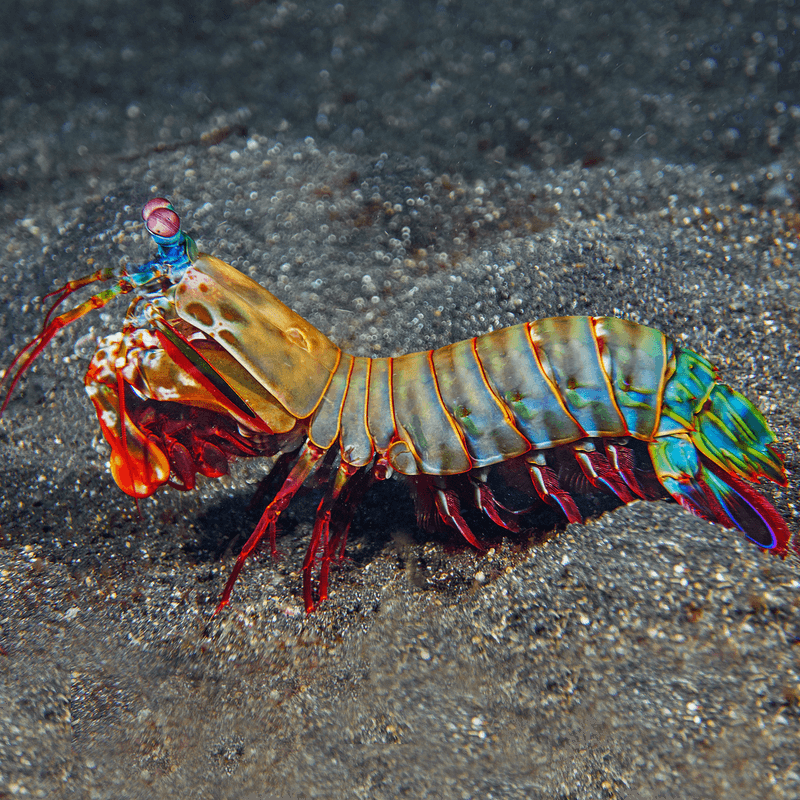
The mantis shrimp, a small but mighty creature, packs a punch that belies its size. Known for its powerful claws, it can strike with the speed of a bullet, making it a formidable hunter. These claws can shatter glass and crack open shells with ease. Found in tropical and subtropical waters, mantis shrimp come in a dazzling array of colors. Their eyes are among the most complex in the animal kingdom, capable of seeing polarized and ultraviolet light. The mantis shrimp’s vibrant appearance and incredible abilities make it a true marvel of the ocean.
Vampire Squid
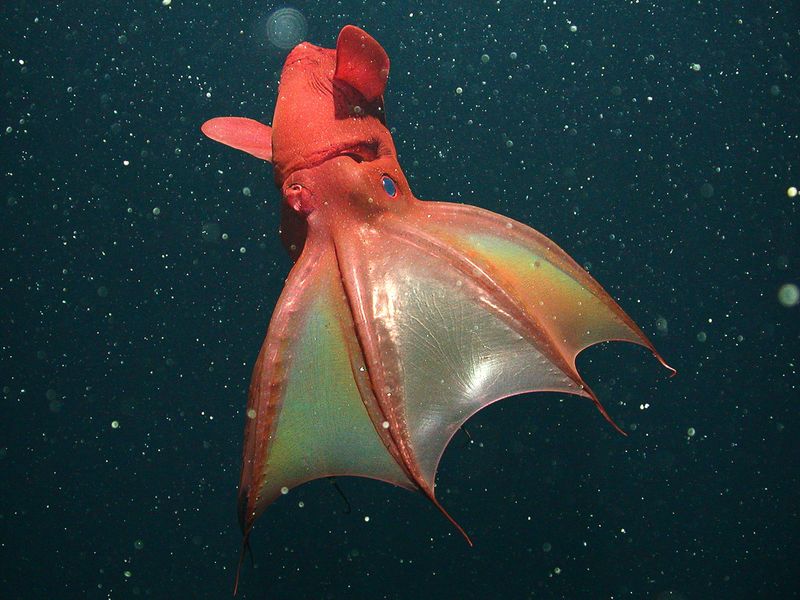
The vampire squid, with its eerie name and appearance, intrigues those who study the deep sea. Its webbed arms and glowing blue eyes give it a ghostly presence. Unlike its name suggests, it doesn’t suck blood but feeds on detritus. Found in oxygen-minimum zones, it thrives in environments with little oxygen. The vampire squid’s bioluminescent capabilities allow it to communicate and evade predators. Despite its fearsome name, it is a peaceful creature, navigating the depths with grace. Its unique adaptations make the vampire squid a fascinating study in survival.
Anglerfish
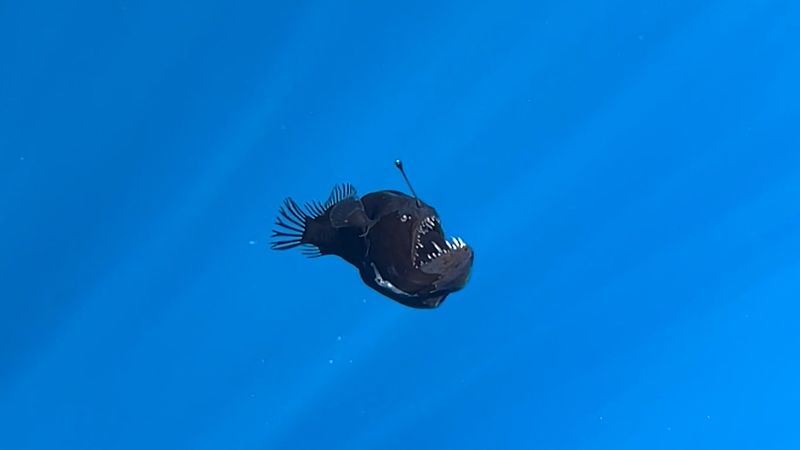
The anglerfish, with its captivating bioluminescent lure, is a marvel of the deep sea. This adaptation helps it attract prey in the pitch-black depths where it resides. Found in oceans worldwide, the anglerfish is most famous for its unusual mating habits. Males are significantly smaller and fuse to females, becoming parasitic. This ensures successful reproduction in the vast and desolate deep sea. Despite its fearsome appearance, the anglerfish is a master of survival, using its lure to navigate and hunt. Its existence is a testament to nature’s ingenuity and adaptability.
Frilled Shark
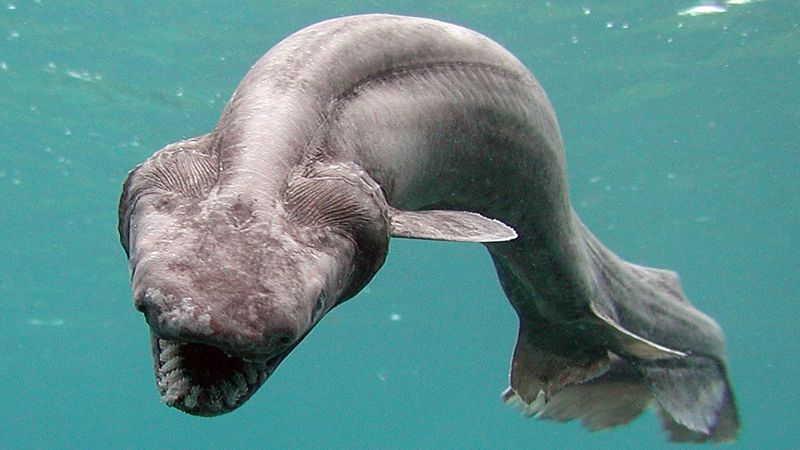
The frilled shark, with its eel-like body and frilly gill slits, is a relic of the prehistoric sea. Often found in the deep, dark waters of the Atlantic and Pacific Oceans, it’s rarely seen by humans. Its flexible jaw and needle-like teeth enable it to swallow prey whole. This ancient creature’s lineage dates back millions of years, giving it the nickname ‘living fossil.’ Despite its fearsome appearance, the frilled shark poses no real threat to humans. Its discovery reminds us of the ocean’s deep history and the remarkable creatures that inhabit it.
Sea Pig
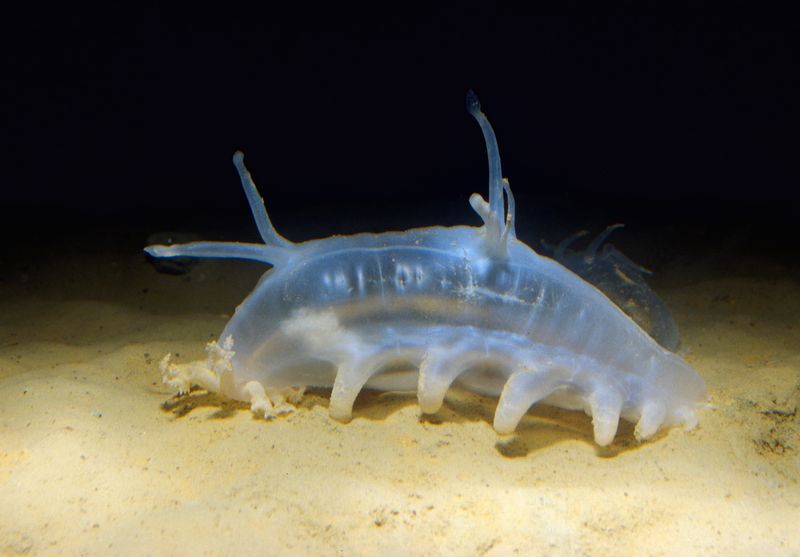
The sea pig, a peculiar type of sea cucumber, crawls along the deep ocean floor. Found in abyssal depths, these soft-bodied creatures move using tube-like legs. Feeding on detritus, they play a crucial role in the ocean ecosystem. Despite their odd appearance, sea pigs are vital for nutrient cycling. They often travel in herds, filtering organic matter from the sediments. Their presence in the deep sea highlights the diversity and interconnectedness of marine life. Sea pigs, with their unusual features and important ecological role, are a reminder of the ocean’s complexity.
Pelican Eel
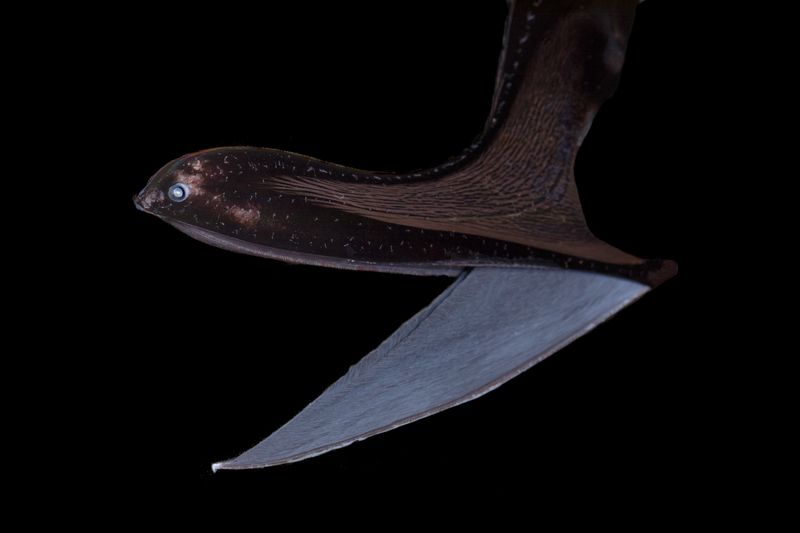
The pelican eel, with its massive, expandable mouth, fascinates those who explore the ocean’s twilight zone. Its jaw can open wide enough to swallow prey much larger than itself. This adaptation is crucial in the scarce deep-sea environment. Despite its name, it isn’t closely related to true eels. Instead, it’s part of a family of fish uniquely adapted to the deep sea. The pelican eel’s bioluminescent tail acts as a lure, attracting prey in the dark waters. Its unusual appearance and feeding habits make it a captivating subject of study.
Fangtooth Fish
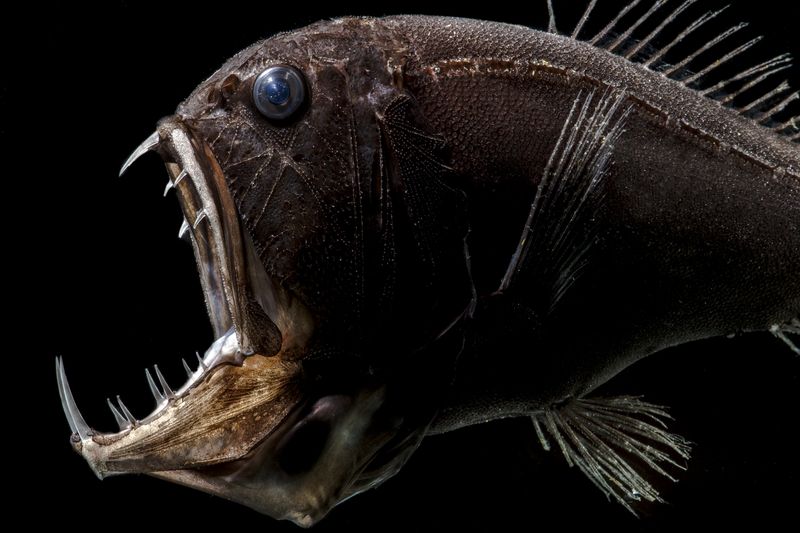
The fangtooth fish, named for its prominent, needle-like teeth, is a formidable predator of the deep sea. Despite its fearsome appearance, it’s relatively small, rarely exceeding six inches. Found in ocean depths greater than 5,000 feet, the fangtooth fish is adapted to extreme conditions. Its large teeth and powerful jaws are essential for capturing prey in the dark waters. This fish’s ability to withstand the intense pressure of the deep ocean is remarkable. The fangtooth fish, with its menacing look and survival skills, embodies the harsh realities of deep-sea life.
Christmas Tree Worm
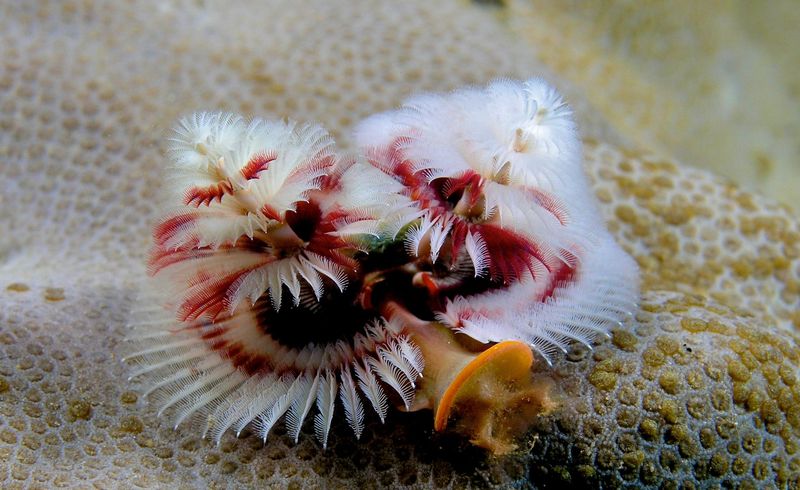
The Christmas tree worm, with its vibrant spiral plumes, is a favorite among divers and marine photographers. Found on coral reefs worldwide, it earns its name from its tree-like appearance. These plumes are actually specialized appendages used for feeding and respiration. When threatened, they retract into their tubes for protection. Despite their small size, Christmas tree worms play a significant role in the reef ecosystem. Their presence indicates a healthy reef environment. These stunning creatures, with their dazzling colors and unique form, are a testament to the ocean’s beauty and diversity.
Sea Angel
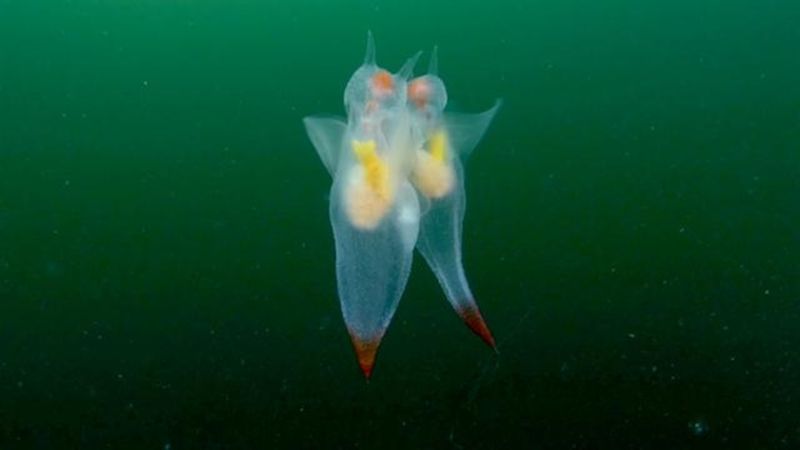
The sea angel, a type of pelagic sea slug, mesmerizes with its ethereal, wing-like flaps. Found in cold oceans, particularly the Arctic, it glides gracefully through the water. Despite its angelic appearance, it’s a fierce predator. Feeding primarily on sea butterflies, it uses specialized tentacles to catch prey. The sea angel’s transparent body reveals its internal organs, adding to its otherworldly charm. Its presence in the ocean highlights the delicate balance of marine ecosystems. Sea angels, with their unique adaptations and beauty, captivate marine biologists and ocean lovers alike.
Stonefish
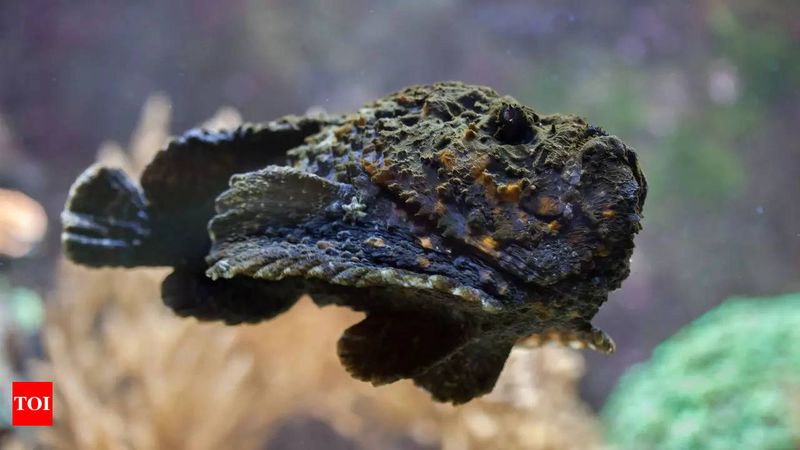
The stonefish, often hailed as the most venomous fish, is a master of disguise. Found in shallow tropical waters, it camouflages perfectly with rocks and coral. This stealth allows it to ambush unsuspecting prey. Its venomous spines are a formidable defense against predators. While it poses a threat to humans, encounters are rare, and antivenom is available. The stonefish’s ability to blend seamlessly into its environment is both impressive and a reminder of nature’s potential dangers. Its presence in the ocean ecosystem is vital, maintaining the balance of marine life.
Blue Dragon
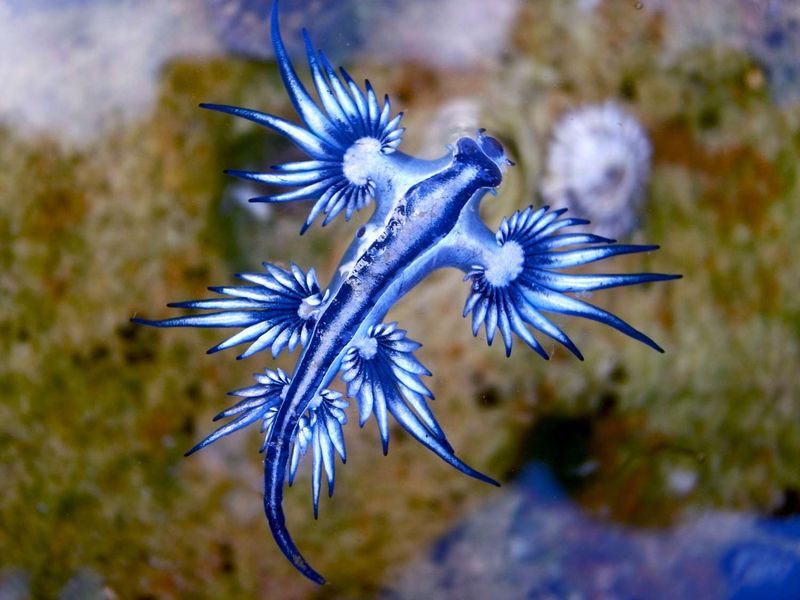
The blue dragon, a strikingly beautiful sea slug, drifts along the ocean’s surface. Known scientifically as Glaucus atlanticus, it feeds on venomous jellyfish, storing their toxins for its own defense. Its brilliant blue and silver coloration provides camouflage against aerial and underwater predators. Despite its delicate appearance, the blue dragon is a formidable survivor. Found primarily in warm ocean waters, it moves with the currents, living a life of constant drift. The blue dragon’s unique lifestyle and stunning looks make it a favorite subject for marine photographers and enthusiasts.
Dragonfish
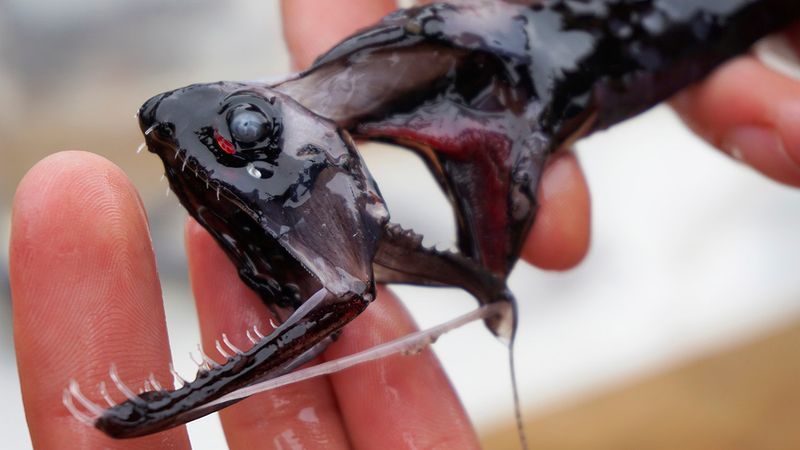
The dragonfish, with its menacing look and bioluminescent features, is a predator of the deep. Found at depths of up to 5,000 feet, it is well adapted to the dark ocean environment. Its bioluminescent spots and light-emitting barbel lure prey within striking distance. Despite its small size, the dragonfish is a formidable hunter. Its long, fang-like teeth are perfect for gripping slippery prey. The dragonfish’s ability to produce light in the pitch-black depths is a remarkable adaptation. This eerie yet fascinating creature exemplifies the wonders of the deep sea.
Hairy Frogfish
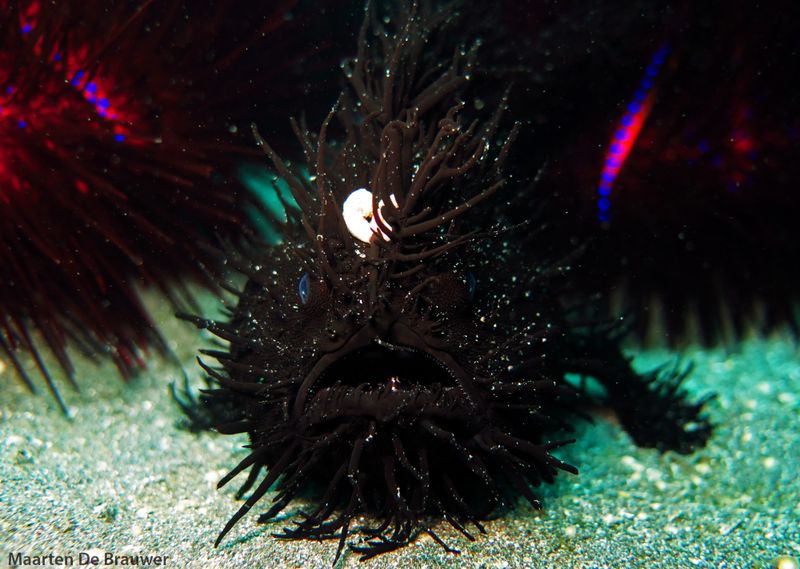
The hairy frogfish, with its bizarre appearance, is a master of deception. Its name comes from the hair-like appendages that cover its body, helping it blend into the ocean floor. Using its lure, which resembles a small worm or shrimp, it attracts prey within striking distance. Found in tropical and subtropical waters, it often goes unnoticed due to its excellent camouflage. The frogfish’s ambush technique is both fascinating and effective, allowing it to catch unsuspecting victims. Its unique adaptations make the hairy frogfish a captivating subject for divers and researchers.
Narwhal
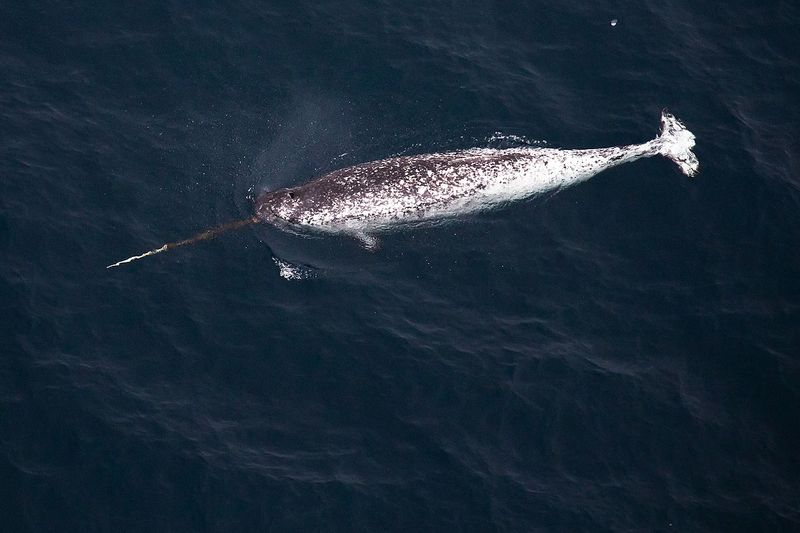
The narwhal, often called the unicorn of the sea, is known for its long, spiral tusk. Found primarily in the Arctic Ocean, this tusk is actually an elongated tooth, reaching lengths of up to ten feet. Narwhals use their tusks for various purposes, including sensing environmental changes. These social creatures travel in pods, communicating with a range of clicks and whistles. Despite their remote habitat, narwhals face threats from climate change and human activities. The narwhal’s enigmatic tusk and Arctic lifestyle make it a symbol of the wonders and fragility of marine ecosystems.
Mimic Octopus
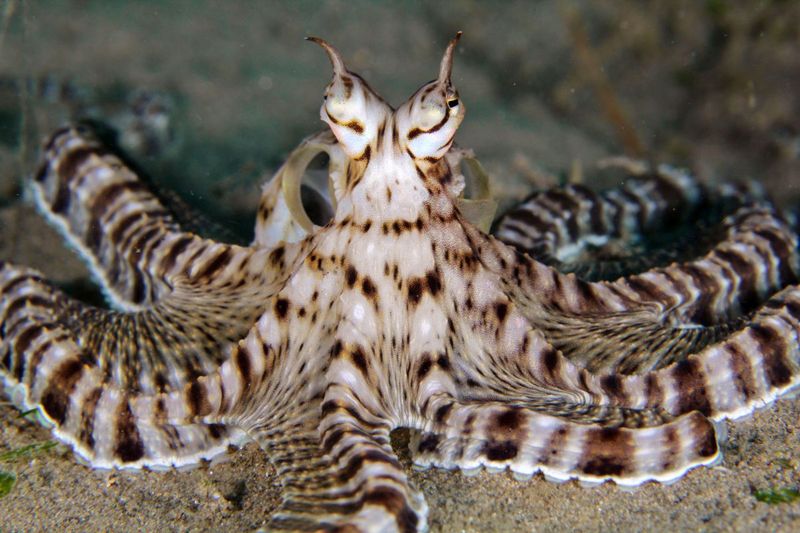
The mimic octopus, a true master of disguise, can imitate a variety of marine animals. Found in the tropical waters of Southeast Asia, it changes shape and color to mimic creatures like lionfish and sea snakes. This remarkable ability helps deter predators and confuse prey. Unlike most octopuses, it can switch between multiple impersonations. The mimic octopus’s intelligence and adaptability are astonishing, showcasing nature’s ingenuity. Its unique behavior not only provides protection but also fascinates scientists and divers. The mimic octopus is a true testament to the creativity of evolution.
Salp
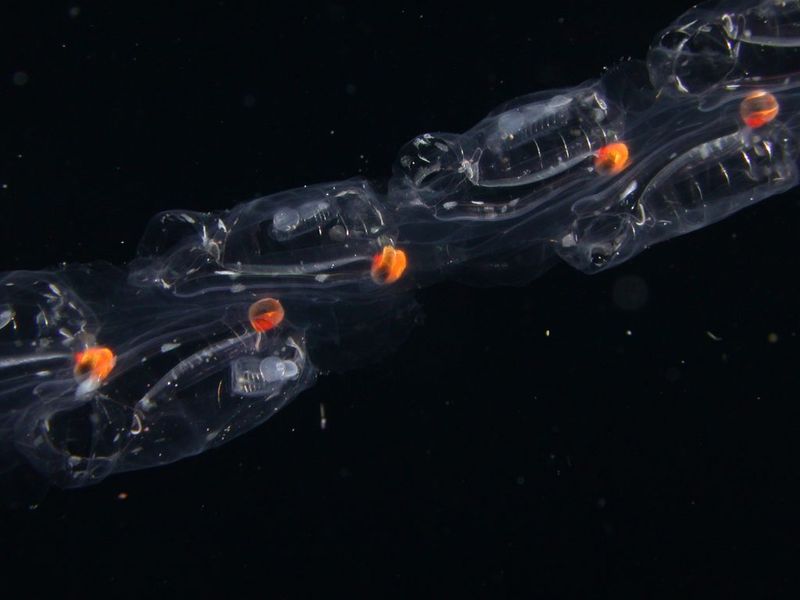
Salps, gelatinous creatures often found in chains, drift through the open ocean. These filter feeders play an important role in carbon cycling, consuming large quantities of phytoplankton. Found in both temperate and tropical waters, salps can form massive swarms during plankton blooms. Despite their simple appearance, they are incredibly efficient at converting carbon to energy. The salp’s transparent body and rhythmic contractions allow it to move gracefully through the water. These fascinating creatures highlight the interconnectedness of ocean ecosystems and the delicate balance of marine life. Salps are vital for maintaining ocean health.
Glowing Jellyfish
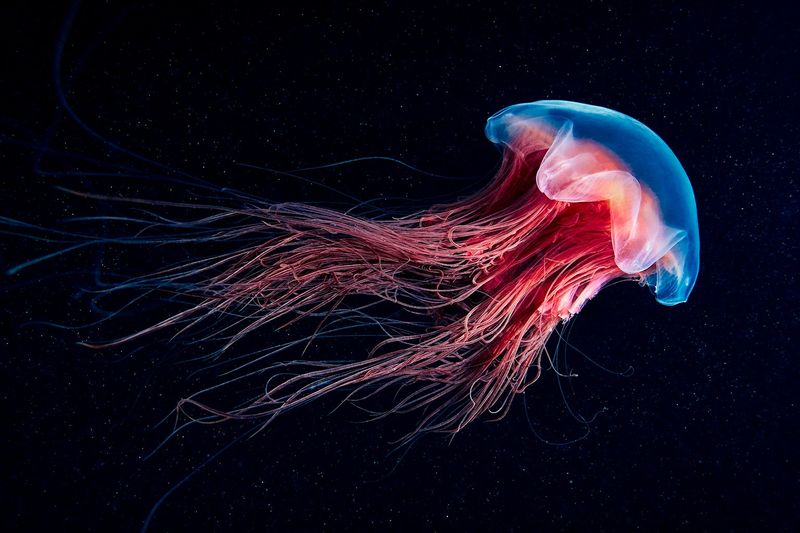
The glowing jellyfish, with its mesmerizing light display, is a true spectacle of the ocean. Found in various oceanic regions, its bioluminescent abilities are both beautiful and functional. These lights can deter predators, attract mates, or confuse prey. Despite their fragile appearance, jellyfish are resilient, having existed for millions of years. Their ability to thrive in diverse environments is a testament to their adaptability. The glowing jellyfish’s ethereal beauty and ancient lineage make it a captivating subject in marine biology. Observing these creatures offers a glimpse into the wonders of the ocean’s depths.
Lizardfish
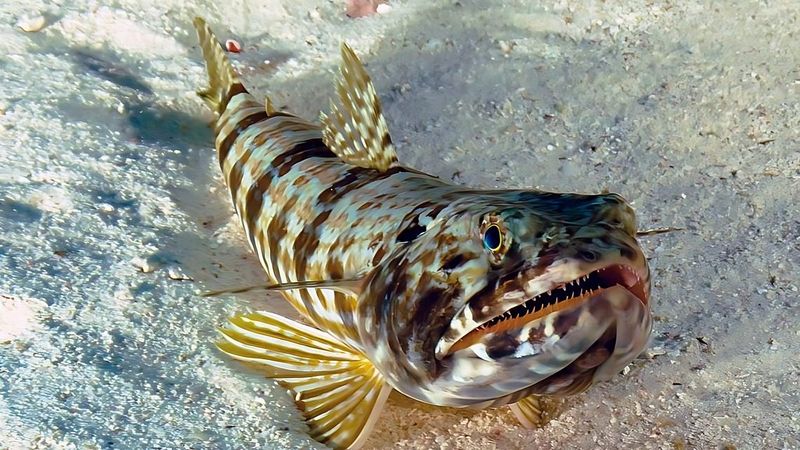
The lizardfish, with its sharp teeth and predatory gaze, is a common inhabitant of sandy ocean floors. Found in tropical and subtropical waters, it is a master of ambush. Its ability to blend into the sandy substrate allows it to surprise unsuspecting prey. Despite its small size, the lizardfish is a voracious predator, feeding on fish and invertebrates. Its excellent camouflage and swift attack make it a successful hunter. The lizardfish’s presence in the marine ecosystem highlights the intricate web of predator and prey relationships that sustain ocean life.
Pink See-Through Fantasia
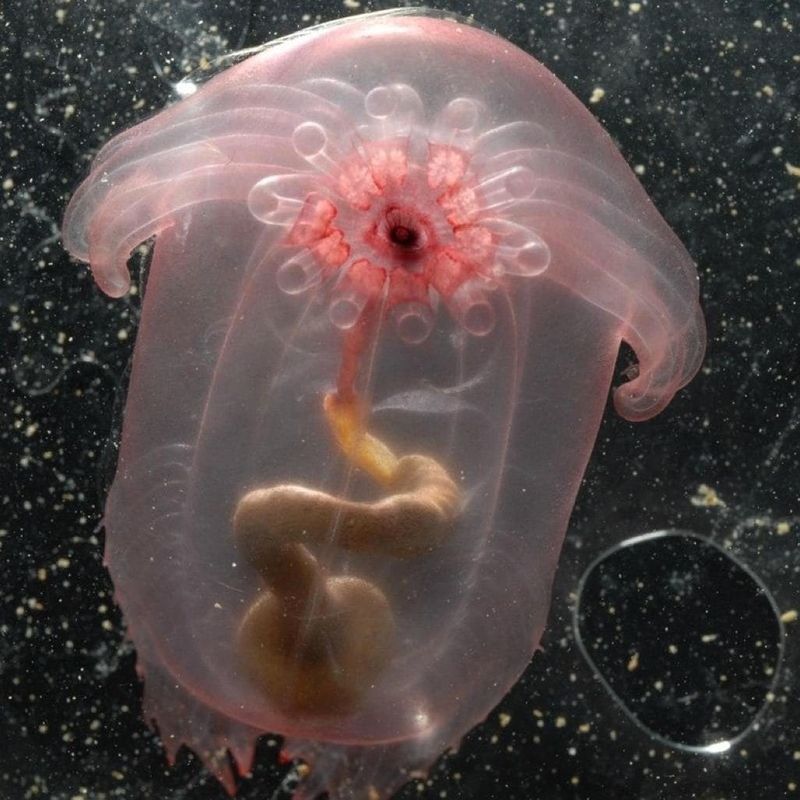
Meet the Pink See-Through Fantasia, a mesmerizing sea cucumber that drifts through the ocean like a ghostly apparition. Its gelatinous body is almost entirely transparent, with a subtle pink hue that sets it apart from the surrounding darkness.
This ethereal creature calls the deep waters of the Celebes Sea home, where it gracefully navigates the currents. Its delicate, feathery appendages fan out from its body, creating a captivating display as it moves.
Aside from its beauty, the Pink See-Through Fantasia is known for its bioluminescence, casting a faint glow in the inky depths. This enchanting light show is not just for aesthetic purposes; it serves as a defense mechanism, deterring potential predators.

